Physical Therapy Billing in Workers' Compensation Cases: Maximizing Reimbursement and Compliance
Struggling with denials or delayed payments for your physical therapy services in workers' compensation cases? Discover how mastering accurate coding, thorough documentation, and compliance can transform your billing process and maximize reimbursements. Get actionable tips to streamline your operations and avoid common pitfalls in our comprehensive guide to physical therapy billing for workers’ compensation.
Essential Tips for Accurate Billing, Documentation, and Avoiding Denials in Workers' Compensation Cases
In workers' compensation cases, physical therapy is a key part of the recovery process for many injured workers. However, billing for physical therapy (PT) within this setting presents unique challenges that can lead to delays, denials, or underpayment if not handled correctly. This guide breaks down best practices for PT billing in workers' compensation, focusing on critical areas like coding, compliance, and documentation to ensure accurate reimbursements.
Why Physical Therapy is Critical in Workers’ Compensation
Physical therapy supports injured workers by helping them regain strength, flexibility, and function after a work-related injury. Whether it’s rehabilitating a back injury or addressing chronic pain, PT is central to the treatment plan, making it essential that billing practices align with guidelines to ensure proper compensation.
Key Components of Physical Therapy Billing in Workers' Compensation
1. Accurate Coding for Physical Therapy Services Coding correctly is fundamental to successful billing. The following are common CPT codes for physical therapy services in workers’ compensation cases:
- 97110 (Therapeutic Exercise): Developing strength, endurance, and flexibility.
- 97112 (Neuromuscular Re-Education): Techniques to improve movement and balance.
- 97140 (Manual Therapy): Hands-on interventions like soft tissue mobilization.
- 97530 (Therapeutic Activities): Dynamic activities to enhance functional performance.
Each code must be accompanied by detailed documentation that explains the rationale for treatment, the objectives, and the progress being made.
Tip: For timed services like 97110, be meticulous in documenting the exact time spent on each treatment. Accurate tracking and documentation are essential to avoid payment reductions or audit risks.
2. Thorough Documentation: The Backbone of Effective PT Billing In workers' compensation cases, comprehensive documentation is essential. Detailed records not only support the claim but also justify the continued care required. Your documentation should include:
- Initial Evaluation: The patient’s medical history, injury specifics, and the goals of therapy.
- Ongoing Progress Notes: Notes for each session that cover patient progress, adjustments to the treatment plan, and measurable outcomes such as range of motion improvements.
- Discharge Summary: A summary of the treatment course, patient outcomes, and readiness to return to work.
Real-World Example: A physical therapy clinic in California reduced claim denials by 20% after revising its documentation approach to provide clearer progress notes that aligned closely with treatment goals and demonstrated measurable patient improvements.
3. Navigating Pre-Authorization and Utilization Reviews Pre-authorization is often a requirement for workers’ compensation cases, particularly for extended or complex therapy plans. Utilization reviews (UR) evaluate whether the treatment is medically necessary and aligns with state guidelines, like California’s Medical Treatment Utilization Schedule (MTUS).
- Pre-Authorization Best Practices: Submit a well-structured request with a detailed treatment plan, expected duration, and supporting clinical documentation.
- Dealing with Denials: If a treatment is denied, appeal promptly by presenting evidence such as research studies or additional progress notes that justify the medical necessity of the therapy.
4. Staying Compliant with State-Specific Fee Schedules Workers' compensation billing involves navigating fee schedules that differ from commercial insurance. In California, for example, the Division of Workers’ Compensation (DWC) regularly updates its Official Medical Fee Schedule (OMFS) based on Medicare’s Resource-Based Relative Value Scale (RBRVS). Understanding and applying these updates is key to accurate billing.
Actionable Insight: Regularly review fee schedule updates and use billing software that automates updates to avoid underbilling and ensure compliance.
Common Challenges in Physical Therapy Billing and Solutions
- Insufficient Documentation Leading to Denials Insurers often deny claims if documentation doesn’t adequately justify the treatment. Mitigate this by ensuring that every session note clearly aligns with treatment goals and provides measurable outcomes.
- Frequency and Duration Limits Workers’ compensation may impose limits on the number of sessions or duration of care. Staying within these guidelines—or securing additional authorization—is crucial to avoid billing issues.
- Coding Inaccuracies Mistakes like using incorrect CPT codes or omitting necessary modifiers can result in denials. Implement regular audits to catch these errors before submitting claims.
FAQ Section:
- Q: What happens if a patient needs more physical therapy sessions than allowed?
- A: Submit a progress report with objective measures (like strength tests) that justify the need for additional therapy
Best Practices for Maximizing Reimbursement
- Ongoing Staff Training: Regular training sessions keep your billing team updated on changing guidelines, ensuring compliance and reducing errors.
- Leverage Technology: Invest in billing software that integrates workers' compensation rules, updates fee schedules automatically, and tracks authorization requirements.
- Structured Appeals Process: Develop a system for managing appeals with well-documented evidence supporting your claims, increasing the likelihood of successful resolutions.
Conclusion
Mastering physical therapy billing for workers' compensation requires a deep understanding of coding, documentation, and regulatory guidelines. By focusing on these key elements, healthcare providers can enhance reimbursement rates while delivering the best care possible.
Interested in Partnering with Medrina Technology Management?
At Medrina Technology Management, we specialize in helping providers navigate the complexities of workers' compensation billing. From fee schedule updates to optimizing documentation, we ensure your practice remains compliant while maximizing revenue. Contact us to learn how we can support your goals
Stay updated with the latest insights and news in medical billing services and workers' compensation billing and collections. Enter your email below to subscribe to our blog
Most Recent Articles




